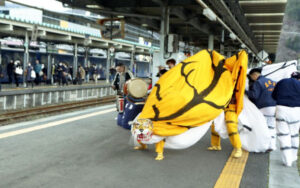今年は寅年ですが、三陸海岸のSLの駅では、虎舞が行われているようです。
SLが到着するとパフォーマンスを披露する。
寅年なので、いろんな虎に関することが注目されますが、今日もそのような話題です。
では、記事全体を読んでみたいと思います。

12月4日、花巻からJR釜石駅のホームにSL銀河が到着すると、只越虎舞と呼ばれる釜石の虎舞保存グループが、負傷した虎が暴走する様子を描いた「ジャンプ虎」を披露した。
Passengers stopped to watch the dance and take pictures after being greeted with such a flashy welcome.
そんな派手な歓迎で迎えられた後、乗客はダンスを見たり写真を撮ったりするために立ち止まった。
The toramai tiger dance, a type of shishimai lion dance, has been handed down as traditional culture in the city and towns of Kamaishi, Otsuchi and Yamada along the Sanriku coast.
獅子舞の一種である虎舞は、三陸海岸の釜石市、大槌町、山田町で伝統文化として受け継がれています。
There have been fewer opportunities over the past two years to perform tiger dances due to the pandemic, so every Saturday since October, various groups in the city have performed on a rotating basis.
パンデミックにより、過去2年間、虎の踊りを披露する機会が少なくなったため、10月から毎週土曜日に市内のさまざまなグループが交代で踊っています。
“This is the Year of the Tiger, so we hope to have more opportunities to perform,” said Itaru Kitayama of Tadakoe Toramai.
「今年は寅年なので、もっとたくさんの機会があればいいなと思っています」と只越虎舞の北山伊太郎は語った。
Toramai is said to have originated in the Heian period (794-1192), when warlords had their warriors dance in tiger costumes to inspire their subordinates.
虎舞は平安時代(794〜 1192年)に武将が部下を鼓舞するために虎の衣装を着て踊らせた時代に始まったと言われています。
では、いつもの通り、1文ずつ文章を細かく見ていこうと思います。
12月4日に花巻からJR釜石駅のプラットホームにSL銀河が到着した(the SL Ginga train arrived)時、只越虎舞と呼ばれる釜石の虎舞保存グループ(a tiger dance preservation group)が、負傷した虎(a wounded tiger)が荒々しく走る(running wild)様子を描いた(depicts)「虎舞」を披露した(performed)。
釜石駅にSL銀河が到着すると、只越虎舞と呼ばれるグループが虎舞を披露した。
只越虎舞は、釜石の虎舞保存グループ。
「虎舞」は負傷した虎が、ワイルドに走る様子を描いたパフォーマンスです。
“preservation”は「保存、保護、維持」という意味。
“a wounded tiger”で「負傷した虎」と表現しています。
“wonded”は「負傷した」という意味です。
“depicts”は「描写する」という意味の動詞。ちょっと難しい。
そのような派手な歓迎(such a flashy welcome)で出迎えられた(being greeted)あと、乗客たちはダンスを見たり、写真を撮ったりするために立ち止まった(stopped)。
SL銀河の乗客たちは、そのような派手な歓迎を受けた。
そのあと、立ち止まって、虎舞を見たり、その写真を撮ったりした。
“such a flashy welcome”で「そのような派手な歓迎」と表現しています。
“flashy”は「派手な、閃光のような」という意味。”flash”「フラッシュ」から来ていますね。
“stopped to watch”というので、「見るために
獅子舞の一種である虎舞は、三陸海岸沿岸(along the Sanriku coast)の釜石市、大槌町、山田町で伝統文化として(as traditional culture)受け継がれています(has been handed down)。
虎舞は獅子舞の一種だそうです。
三陸海岸沿いの地域で、伝統文化として引き継がれている。
確かに虎の顔をしていますが、獅子舞に似た感じですね。
“has been handed down”で「受け継がれている」という表現です。
現在完了の受身形。
ずーっと引き継がれ続けているということを表しています。
パンデミックのために(due to the pandemic)、過去2年間以上(over the past two years)、虎の舞を披露する機会が少なくなった(have been fewer opportunities)ので、10月から毎週土曜日に市内の様々なグループ(various groups)が基本的に交代で(on a rotating basis)踊っています。
虎舞はここ2年以上、披露する機会が少なくなっていたようです。
なので、去年の10月から毎週土曜日に交代で踊るようになった。
市内のいろんなグループが、基本的に持ち回りで披露しているようです。
“due to the pandemic”で「パンデミックのために」と表現しています。
“due to ~”は「~を理由として」という意味という使い方です。
“various groups”で「様々なグループ」という意味。
「今年は寅年です、なので、披露をするもっとたくさんの機会があれば(have more opportunities)いいなと思っています(hope)。」と只越虎舞の北山伊太郎は話した。
今年は寅年なので、虎の舞も注目を浴びるだろうということです。
なので、もっとパフォーマンスする機会があればいいのになぁ。と只越虎舞の北山伊太郎さんは話しています。
“opportunities”は「機会」という意味。
「~ならいいのにな」ということを表現するには、”hope to ~”がよく使われます。
虎舞は平安時代に(in the Heian period)武将(warlords)が部下(subordinates)を鼓舞するために(to inspire)虎の衣装を着させた(in tiger costumes)武士(warriors)を躍らせた(had their warriors dance)時に始まった(have originated)と言われています。
虎舞の歴史は非常に古いです。
平安時代に始まったということのようです。
平安時代に武将が部下を鼓舞するために、武士に虎の衣装を着させて踊らさせたことが起源。
平安時代でも末期でしょうか?武将が出てくるので。
“subordinates”は「部下」という意味。ビジネスではよく出てくる単語です。
“inspire”は「鼓舞する」という表現。「元気づける、感動させる」などの意味もあります。
“had their warriors dance”は「武士を躍らせる」という意味。
ここでの”have”は「~させる」という使役動詞ですね。
今日は、東北の三陸海岸での虎舞の話題でした。
今日も最後まで読んでくださって、ありがとうございました。
こうぷー




























































































































コメント